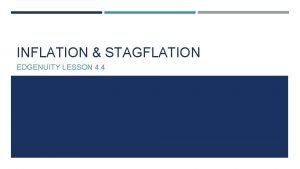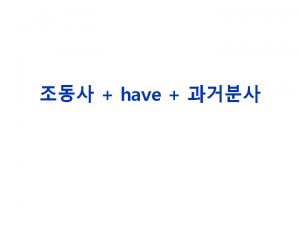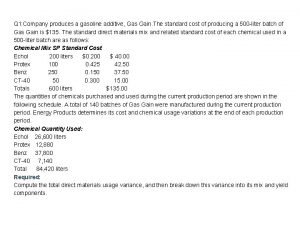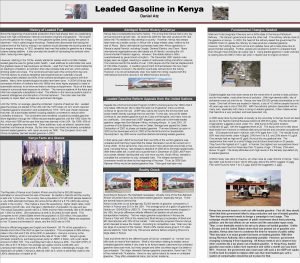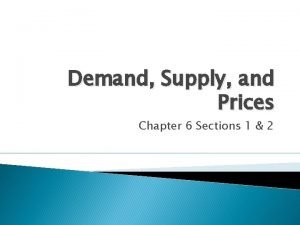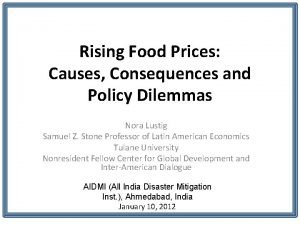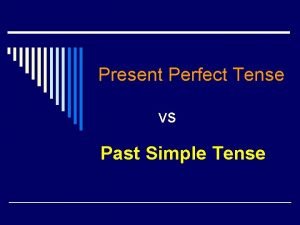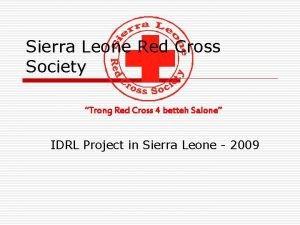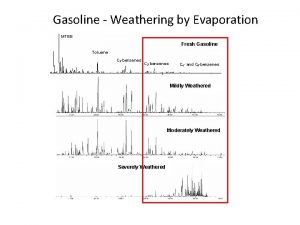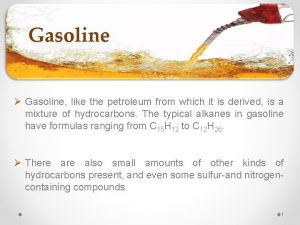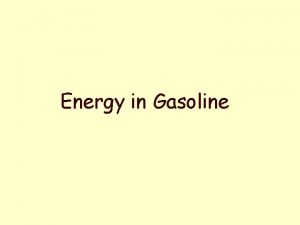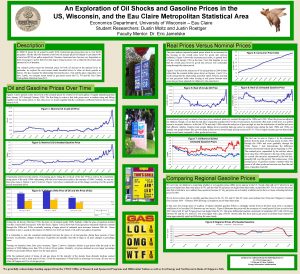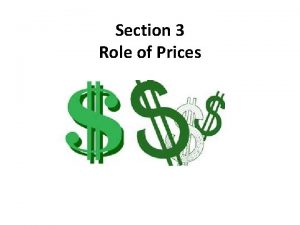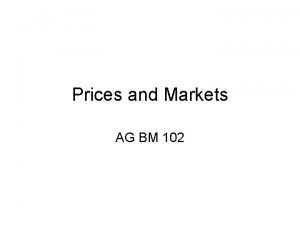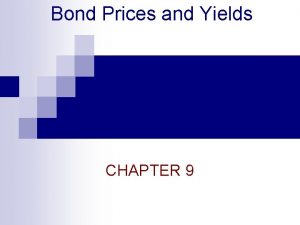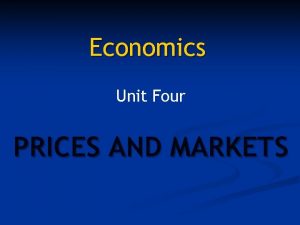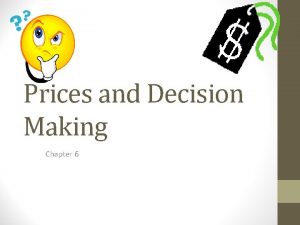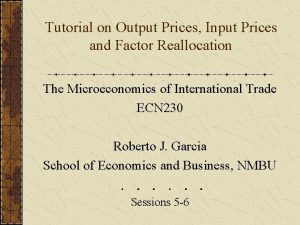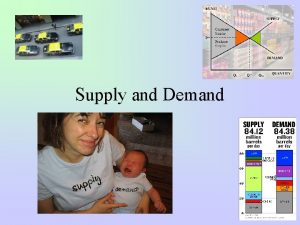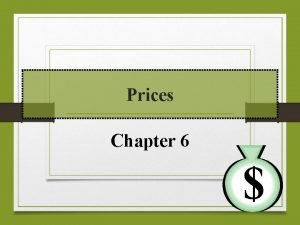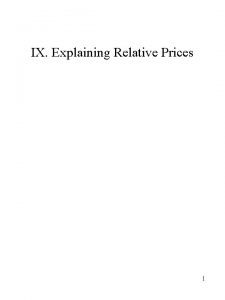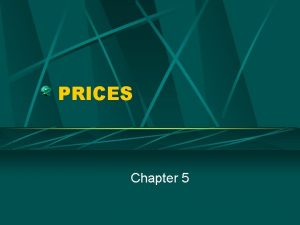Introduction Why have gasoline prices gone up and
















































- Slides: 48

Introduction • Why have gasoline prices gone up and down so dramatically and why do prices change from one day to the next? – In general, gas prices fluctuate as a result of four forces: supply, demand, global trends, and uncertainty. – After studying this chapter, you should be able to answer the learning objectives listed on the next slides. Copyright©© 2017 2012 Pearson. Education, Inc. Copyright Publishing as Prentice Hall 1 -

The Concept of Business and Profit • Business – organization that provides goods or services to earn profits • Profits – difference between a business’s revenues and its expenses Copyright©© 2017 2012 Pearson. Education, Inc. Copyright Publishing as Prentice Hall 1 -2

The External Environment of Business • External Environment – everything outside an organization’s boundaries that might affect it Copyright©© 2017 2012 Pearson. Education, Inc. Copyright Publishing as Prentice Hall 1 -3

Dimensions of the External Environment Copyright©© 2017 2012 Pearson. Education, Inc. Copyright Publishing as Prentice Hall 1 -4

Economic Systems • Economic system – a nation’s system for allocating its resources among its citizens, both individuals and organizations Copyright©© 2017 2012 Pearson. Education, Inc. Copyright Publishing as Prentice Hall 1 -5

Factors of Production • Factors of production – the resources that a country’s businesses use to produce goods and services Copyright©© 2017 2012 Pearson. Education, Inc. Copyright Publishing as Prentice Hall 1 -

Types of Economic Systems • Planned Economy – economy that relies on a centralized government to control all or most factors of production and to make all or most production and allocation decisions – Communism, socialism Copyright©© 2017 2012 Pearson. Education, Inc. Copyright Publishing as Prentice Hall 1 -7

Types of Economic Systems (cont. ) • Market economy – individual producers and consumers control production and allocation by creating combinations of supply and demand Copyright©© 2017 2012 Pearson. Education, Inc. Copyright Publishing as Prentice Hall 1 -8

Types of Economic Systems (cont. ) • Mixed market economy – features characteristics of both planned and market economies • Privatization – process of converting government enterprises into privately owned companies Copyright©© 2017 2012 Pearson. Education, Inc. Copyright Publishing as Prentice Hall 1 -9

Demand Supply in a Market Economy • Demand • Supply – the willingness and ability of buyers to purchase a product (a good or a service) – the willingness and ability of producers to offer a good or service for sale Copyright©© 2017 2012 Pearson. Education, Inc. Copyright Publishing as Prentice Hall 1 -10

Demand Supply Copyright©© 2017 2012 Pearson. Education, Inc. Copyright Publishing as Prentice Hall 1 -11

Demand Supply (cont. ) Copyright©© 2017 2012 Pearson. Education, Inc. Copyright Publishing as Prentice Hall 1 -12

Private Enterprise and Competition in a Market Economy • Private enterprise system – one that allows individuals to pursue their own interests with minimal government restriction – private property rights, freedom of choice, profits, and competition Copyright©© 2017 2012 Pearson. Education, Inc. Copyright Publishing as Prentice Hall 1 -13

Private Enterprise and Competition in a Market Economy (cont. ) 1. Private property rights – ownership of the resources used to create wealth is in the hands of individuals 2. Freedom of choice – you can sell your labor to any employer you choose Copyright©© 2017 2012 Pearson. Education, Inc. Copyright Publishing as Prentice Hall 1 -14

Private Enterprise and Competition in a Market Economy (cont. ) 3. Profits – the lure of profits leads some people to abandon the security of working for someone else and assume the risks of entrepreneurship 4. Competition – occurs when two or more businesses vie for the same resources or customers Copyright©© 2017 2012 Pearson. Education, Inc. Copyright Publishing as Prentice Hall 1 -15

Degrees of Competition Copyright©© 2017 2012 Pearson. Education, Inc. Copyright Publishing as Prentice Hall 1 -16

Degrees of Competition (cont. ) For perfect competition to exist, two conditions must prevail: 1. all firms in an industry must be small, and 2. the number of firms in the industry must be large Copyright©© 2017 2012 Pearson. Education, Inc. Copyright Publishing as Prentice Hall 1 -17

Perfect Competition 1. The products of each firm are so similar that buyers view them as identical to those of other firms. 2. Both buyers and sellers know the prices that others are paying and receiving in the marketplace. 3. Because each firm is small, it is easy for firms to enter or leave the market. 4. Going prices are set exclusively by supply and demand accepted by both sellers and buyers. Copyright©© 2017 2012 Pearson. Education, Inc. Copyright Publishing as Prentice Hall 1 -18

Degrees of Competition (cont. ) • Monopolistic Competition – market or industry characterized by numerous buyers and relatively numerous sellers trying to differentiate their products from those of competitors Copyright©© 2017 2012 Pearson. Education, Inc. Copyright Publishing as Prentice Hall 1 -19

Degrees of Competition (cont. ) • Oligopoly – market or industry characterized by a handful of (generally large) sellers with the power to influence the prices of their products Copyright©© 2017 2012 Pearson. Education, Inc. Copyright Publishing as Prentice Hall 1 -20

Degrees of Competition (cont. ) • Monopoly – market or industry in which there is only one producer that can therefore set the prices of its products • Natural Monopoly – industry in which one company can most efficiently supply all needed goods or services Copyright©© 2017 2012 Pearson. Education, Inc. Copyright Publishing as Prentice Hall 1 -21

Economic Indicators • Economic indicators 경제 지표 – statistics that show whether an economic system is strengthening, weakening, or remaining stable – help assess the performance of an economy Copyright©© 2017 2012 Pearson. Education, Inc. Copyright Publishing as Prentice Hall 1 -22

Economic Growth, Aggregate Output, and Standard of Living • Business cycle 경기순환 – the pattern of short-term ups and downs (or expansions and contractions) in an economy – 경기가 확장(expansion)→후퇴(recession)→수축 (contraction)→회복(recovery) 과정을 반복하면 서 끊임없이 변동하는 일련의 순환과정을 말한 다. Copyright©© 2017 2012 Pearson. Education, Inc. Copyright Publishing as Prentice Hall 1 -23

Economic Growth, Aggregate Output, and Standard of Living • Aggregate output 총수요 – the total quantity of goods and services produced by an economic system during a given period; primary measure of growth in the business cycle – 국민 경제의 모든 경제주체들이 소비와 투자 의 목적으로 사려고 하는 재화와 용역을 모두 합한 것이다. – 총수요 = '민간소비 + 민간 투자 + 정부 소비 및 Copyright©© 2017 2012 Pearson. Education, Inc. 투자 + 수출' Copyright 1 -24 Publishing as Prentice Hall

Economic Growth, Aggregate Output, and Standard of Living (cont. ) • Standard of living 생활수준 – the total quantity and quality of goods and services that they can purchase with the currency used in their economic system Copyright©© 2017 2012 Pearson. Education, Inc. Copyright Publishing as Prentice Hall 1 -25

Gross Domestic Product • Gross domestic product (GDP) 국내 총생산 • refers to the total value of all goods and services produced within a given period by a national economy through domestic factors of production • measure of aggregate output • 총수요 = GDP + 수입 Copyright©© 2017 2012 Pearson. Education, Inc. Copyright Publishing as Prentice Hall 1 -26

Gross Domestic Product (cont. ) Copyright©© 2017 2012 Pearson. Education, Inc. Copyright Publishing as Prentice Hall 1 -27

Gross National Product • Gross national product (GNP) 국민총생산 – refers to the total value of all goods and services produced by a national economy within a given period regardless of where the factors of production are located – 한나라의 국민이 생산한 것을 모두 합한 금액 으로, 우리나라 국민이 외국에 진출해서 생산 한 것도 GNP에 모두 잡히게 된다. Copyright©© 2017 2012 Pearson. Education, Inc. Copyright Publishing as Prentice Hall 1 -28

GDP and GDP per Capita Copyright©© 2017 2012 Pearson. Education, Inc. Copyright Publishing as Prentice Hall 1 -29

Gross Domestic Product • Nominal GDP 명목 국내 총생산 – gross domestic product (GDP) measured in current dollars or with all components valued at current prices 국내총생산(GDP)은 한 나라의 영역 내에서 가계, 기업, 정부 등 모든 경제 주체가 일정 기간 동안 생산활동에 참여하여 창출한 부가가치 또는 최 종 생산물을 시장가격으로 평가한 합계 Copyright©© 2017 2012 Pearson. Education, Inc. Copyright Publishing as Prentice Hall 1 -30

List of GDP by nations 1. USA 2. China 3. Japan 4. Germany Copyright©© 2017 2012 Pearson. Education, Inc. Copyright Publishing as Prentice Hall 1 -31

Gross Domestic Product • Purchasing Power Parity 구매력 평가 지수 – the principle that exchange rates are set so that the prices of similar products in different countries are about the same – 환율의 결정을 각국 화폐의 구매력 차이로 설 명하는 이론 Copyright©© 2017 2012 Pearson. Education, Inc. Copyright Publishing as Prentice Hall 1 -32

World Prices of a Big Mac Copyright©© 2017 2012 Pearson. Education, Inc. Copyright Publishing as Prentice Hall 1 -33

Productivity • Productivity 국가 생산성 – measure of economic growth that compares how much a system produces with the resources needed to produce it $ 1, 000 1 million / 1백만 $ 100, 000 100 million / 1억 $1, 000, 000 1 billion / 10억 Copyright©© 2017 2012 Pearson. Education, Inc. Copyright Publishing as Prentice Hall 1 -34

Productivity (cont. ) • Balance of trade 무역수지 – the economic value of all the products that a country exports minus the economic value of its imported products – Positive or negative balance – 무역수지 흑자 / 적자 Copyright©© 2017 2012 Pearson. Education, Inc. Copyright Publishing as Prentice Hall 1 -35

Productivity (cont. ) • • Korea-China 무역흑자 469억 달러 (2015) Korea-Japan 무역적자 244억 달러 Korea-U. S. 무역흑자 195억 달러 (20조원) Largest trade deficit for U. S. 1. China 2. Japan 3. Germany ……… 8. Korea Copyright©© 2017 2012 Pearson. Education, Inc. Copyright Publishing as Prentice Hall 1 -36

Productivity (cont. ) • National Debt 국채 – the amount of money the government owes its creditors – China is largest holder of Korea’s treasury bonds (17. 51조원) (2016. 02) – U. S. is second with 14. 5조원 Copyright©© 2017 2012 Pearson. Education, Inc. Copyright Publishing as Prentice Hall 1 -37

Productivity (cont. ) • National Debt 국채 United States: $18. 1 trillion (18경원) Korea: $645 billion (645 조원) 40. 1% of GDP increase 202조원 in past 4 years China: $4. 3 trillion (4. 3경원) 41% of GDP Japan: $10. 46 trillion (10. 46경원) Copyright©© 2017 2012 Pearson. Education, Inc. 200% of GDP Copyright Publishing as Prentice Hall 1 -38

Productivity (cont. ) • National Debt 국채 Copyright©© 2017 2012 Pearson. Education, Inc. Copyright Publishing as Prentice Hall 1 -39

Productivity (cont. ) • National Debt 국채 Copyright©© 2017 2012 Pearson. Education, Inc. Copyright Publishing as Prentice Hall 1 -40

Economic Stability • Stability 경제 안정성 – condition in which the amount of money available in an economic system and the quantity of goods and services produced in it are growing at about the same rate Copyright©© 2017 2012 Pearson. Education, Inc. Copyright Publishing as Prentice Hall 1 -41

Economic Stability • Inflation 인플레이션 – occurs when widespread price increases occur throughout an economic system – Inflation Rate in Mexico – Average: 25. 91% (1974~2016) – Feb. 1988: 179. 73% (all-time high) – Dec. 2015: 2. 13% Copyright©© 2017 2012 Pearson. Education, Inc. Copyright Publishing as Prentice Hall 1 -42

Economic Stability (cont. ) • Unemployment 실업율 – the level of joblessness among people actively seeking work in an economic system • Recession 불경기 – a period during which aggregate output, as measured by GDP, declines • Depression 공황 – a prolonged and deep recession Copyright©© 2017 2012 Pearson. Education, Inc. Copyright Publishing as Prentice Hall 1 -43

Managing the U. S. Economy • Fiscal Policies 재정정책 – policies used by a government regarding how it collects and spends revenue – 조세와 정부지출의 수준 및 배분을 조작함으 로써 경제 활동에 영향을 미치기 위해 정부가 사용하는 조치들 Copyright©© 2017 2012 Pearson. Education, Inc. Copyright Publishing as Prentice Hall 1 -44

Managing the U. S. Economy • Monetary Policies 통화(금융)정책 – policies used by a government to control the size of its money supply – 통화당국이 통화량이나 이자율을 조절해 경제 의 안정적 성장을 실현하고자 하는 정책을 말 한다. Copyright©© 2017 2012 Pearson. Education, Inc. Copyright Publishing as Prentice Hall 1 -45

Managing the U. S. Economy (cont. ) • Stabilization Policy 경제안정 정책 – government economic policy intended to smooth out fluctuations in output and unemployment and to stabilize prices Copyright©© 2017 2012 Pearson. Education, Inc. Copyright Publishing as Prentice Hall 1 -46

Applying What You’ve Learned 1. Define the nature of U. S. business, describe the external environments of business, and discuss how these environments affect the success or failure of organizations 2. Describe the different types of global economic systems according to the means by which they control the factors of production. Copyright©© 2017 2012 Pearson. Education, Inc. Copyright Publishing as Prentice Hall 1 -

Applying What You’ve Learned (cont. ) 3. Show markets, demand, and supply affect resource distribution in the United States, identify the elements of private enterprise, and explain the various degrees of competition in the U. S. economic system. 4. Explain the importance of the economic environment to business and identify the factors used to evaluate the performance of an economic system. Copyright©© 2017 2012 Pearson. Education, Inc. Copyright Publishing as Prentice Hall 1 -
 Presente simple en ingles
Presente simple en ingles Andreas carlsson bye bye bye
Andreas carlsson bye bye bye Where has macduff gone and why
Where has macduff gone and why How does banquo describe the witches
How does banquo describe the witches Typically, low inflation is a sign of
Typically, low inflation is a sign of Where have you gone charming billy questions
Where have you gone charming billy questions Something must have gone wrong
Something must have gone wrong Where have you gone charming billy
Where have you gone charming billy Where have all the young people gone
Where have all the young people gone I have seen them riding seaward on the waves analysis
I have seen them riding seaward on the waves analysis I have gone marking analysis
I have gone marking analysis Where have you gone charming billy answer key
Where have you gone charming billy answer key Where have all the criminals gone
Where have all the criminals gone What is mitosis gone wild
What is mitosis gone wild Chapter 42 gasoline injection diagnosis and repair
Chapter 42 gasoline injection diagnosis and repair 6 rectangular faces 8 vertices and 12 edges
6 rectangular faces 8 vertices and 12 edges Dont ask why why why
Dont ask why why why Not because of who i am
Not because of who i am Stoichiometric gasoline
Stoichiometric gasoline Weight-gaining industry examples
Weight-gaining industry examples Is baking bread endothermic or exothermic
Is baking bread endothermic or exothermic Match the description with the example whmis
Match the description with the example whmis A company produces a gasoline additive
A company produces a gasoline additive Leaded gasoline history
Leaded gasoline history A 170 g sample of an unidentified compound contains
A 170 g sample of an unidentified compound contains Chapter 6 prices and decision making assessment answers
Chapter 6 prices and decision making assessment answers Tripod of pricing
Tripod of pricing Chapter 6 demand supply and prices
Chapter 6 demand supply and prices Staples print center prices
Staples print center prices Rising food prices causes and consequences
Rising food prices causes and consequences Banter vs bullying examples
Banter vs bullying examples Remember by christina rossetti
Remember by christina rossetti Present perfect tense examples in hindi
Present perfect tense examples in hindi Plastic surgery gone wrong
Plastic surgery gone wrong Lie past tense
Lie past tense Gone too far childnet
Gone too far childnet Saigon is gone poem
Saigon is gone poem Why does janie visit jody on his deathbed
Why does janie visit jody on his deathbed Amazing grace i've been set free
Amazing grace i've been set free Who is dr tamba in a long way gone
Who is dr tamba in a long way gone Oedipus rex quiz
Oedipus rex quiz The fifth gospel isaiah
The fifth gospel isaiah Plexr
Plexr Linkedin getting started
Linkedin getting started Structural/formalist approach
Structural/formalist approach Seven ages of film
Seven ages of film Romeo and juliet script
Romeo and juliet script He is in america
He is in america Rozdíl mezi been a gone
Rozdíl mezi been a gone




